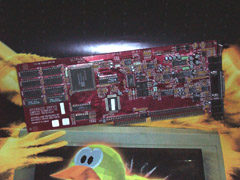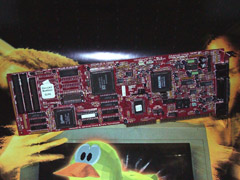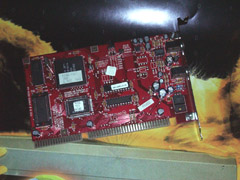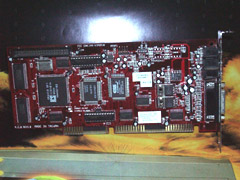|
|
 The Gravis Ultrasound (which was later referred to as 'Ultrasound Classic') was the first
ever consumer soundcard to offer wavetable synthesis with full 32-voice polyphony. The
earlier board revisions (pre-3.7) didn't have mixing abilities, so global volume had to
be adjusted by scaling the GF1 voice volumes independently. Board revisions 3.7 and above
included the ICS2101 mixer chip, which is small SOIC package near the GF1 PLCC socket. The
GF1 also lacked the ability to sample audio with 16-bit resolution, so Gravis sold a separate
16-bit sampling daughtercard which connected to the long row of pins right above the ISA
connector edge. The daughtercards were rather rare and their installation was troublesome
due to to several jumpers that had to be altered to route all audio inputs and outputs to
the Crystal CS4231 codec on the daughtercard.
The Gravis Ultrasound (which was later referred to as 'Ultrasound Classic') was the first
ever consumer soundcard to offer wavetable synthesis with full 32-voice polyphony. The
earlier board revisions (pre-3.7) didn't have mixing abilities, so global volume had to
be adjusted by scaling the GF1 voice volumes independently. Board revisions 3.7 and above
included the ICS2101 mixer chip, which is small SOIC package near the GF1 PLCC socket. The
GF1 also lacked the ability to sample audio with 16-bit resolution, so Gravis sold a separate
16-bit sampling daughtercard which connected to the long row of pins right above the ISA
connector edge. The daughtercards were rather rare and their installation was troublesome
due to to several jumpers that had to be altered to route all audio inputs and outputs to
the Crystal CS4231 codec on the daughtercard.
| Gravis Ultrasound MAX |
| 1994 |
 Maybe because of the trouble with the 16-bit sampling daughtercard with the Classic or
just to cut production costs, Advanced Gravis decided to combine the GF1 and the CS4231 codec
from the daughtercard onto a single soundcard, the Ultrasound MAX. This card became very popular
among amateur musicians because of it's combination of clean wavetable synthesis and high
quality audio codec for sampling and software playback. Since the GF1 and CS4231 had separate
IRQs, it was possible to use both chips simultaneously, thus allowing the PC to be used, for
example, as a real-time effect processor for an electric guitar. Still, after five years, the
Ultrasound MAX is used a lot by people who care about sound quality.
Maybe because of the trouble with the 16-bit sampling daughtercard with the Classic or
just to cut production costs, Advanced Gravis decided to combine the GF1 and the CS4231 codec
from the daughtercard onto a single soundcard, the Ultrasound MAX. This card became very popular
among amateur musicians because of it's combination of clean wavetable synthesis and high
quality audio codec for sampling and software playback. Since the GF1 and CS4231 had separate
IRQs, it was possible to use both chips simultaneously, thus allowing the PC to be used, for
example, as a real-time effect processor for an electric guitar. Still, after five years, the
Ultrasound MAX is used a lot by people who care about sound quality.
| Gravis Ultrasound Ace |
| 1995 |
 The Ultrasound Ace was directed at customers who didn't want to abandon their old soundcard
(usually a Sound Blaster) but weren't quite satisfied with the pathetic FM synthesis their
old card offered. Ultrasound Ace didn't have an built-in amplifier, nor did it have the
timer registers on ports 388/389 which overlapped with the OPL-2/3 FM synthesizers. This
allowed people to plug an Ultrasound Ace next to their old sound card and route the output
of the Ace to the old card with an external "pass-through" cable that was supplied with
the card.
The Ultrasound Ace was directed at customers who didn't want to abandon their old soundcard
(usually a Sound Blaster) but weren't quite satisfied with the pathetic FM synthesis their
old card offered. Ultrasound Ace didn't have an built-in amplifier, nor did it have the
timer registers on ports 388/389 which overlapped with the OPL-2/3 FM synthesizers. This
allowed people to plug an Ultrasound Ace next to their old sound card and route the output
of the Ace to the old card with an external "pass-through" cable that was supplied with
the card.
| Gravis Ultrasound Extreme |
| 1996 |
 As the gaming industry gradually moved to Windows and DirectX, the Ultrasound cards were
in trouble since the GF1 chip lacked drivers with DirectSound support and the WSS driver didn't recognize
Ultrasound MAX's CS4321 codec. To remedy this, Advanced Gravis released the Ultrasound Extreme, which
was actually designed by a Taiwanese company called Synergy and marketed in Asia under the
name ViperMAX. In addition to the trusty GF1 chip, the Ultrasound Extreme had an ESS Audiodrive
1688 codec for full hardware SB Pro and OPL2/3 FM-synthesis support.
Although being software-configurable, the Ultrasound Extreme wasn't an ISA Plug'n'Play card, thus
making it incredibly easy to install and configure (unlike the AWE32 PnP). Shortly after the
Ultrasound Extreme had been released, Advanced Gravis announced their withdrawal from the soundcard
industry and the remaining Ultrasound Extremes were quickly bought by GUS-fans (like me).
As the gaming industry gradually moved to Windows and DirectX, the Ultrasound cards were
in trouble since the GF1 chip lacked drivers with DirectSound support and the WSS driver didn't recognize
Ultrasound MAX's CS4321 codec. To remedy this, Advanced Gravis released the Ultrasound Extreme, which
was actually designed by a Taiwanese company called Synergy and marketed in Asia under the
name ViperMAX. In addition to the trusty GF1 chip, the Ultrasound Extreme had an ESS Audiodrive
1688 codec for full hardware SB Pro and OPL2/3 FM-synthesis support.
Although being software-configurable, the Ultrasound Extreme wasn't an ISA Plug'n'Play card, thus
making it incredibly easy to install and configure (unlike the AWE32 PnP). Shortly after the
Ultrasound Extreme had been released, Advanced Gravis announced their withdrawal from the soundcard
industry and the remaining Ultrasound Extremes were quickly bought by GUS-fans (like me).
|








 The Gravis Ultrasound (which was later referred to as 'Ultrasound Classic') was the first
ever consumer soundcard to offer wavetable synthesis with full 32-voice polyphony. The
earlier board revisions (pre-3.7) didn't have mixing abilities, so global volume had to
be adjusted by scaling the GF1 voice volumes independently. Board revisions 3.7 and above
included the ICS2101 mixer chip, which is small SOIC package near the GF1 PLCC socket. The
GF1 also lacked the ability to sample audio with 16-bit resolution, so Gravis sold a separate
16-bit sampling daughtercard which connected to the long row of pins right above the ISA
connector edge. The daughtercards were rather rare and their installation was troublesome
due to to several jumpers that had to be altered to route all audio inputs and outputs to
the Crystal CS4231 codec on the daughtercard.
The Gravis Ultrasound (which was later referred to as 'Ultrasound Classic') was the first
ever consumer soundcard to offer wavetable synthesis with full 32-voice polyphony. The
earlier board revisions (pre-3.7) didn't have mixing abilities, so global volume had to
be adjusted by scaling the GF1 voice volumes independently. Board revisions 3.7 and above
included the ICS2101 mixer chip, which is small SOIC package near the GF1 PLCC socket. The
GF1 also lacked the ability to sample audio with 16-bit resolution, so Gravis sold a separate
16-bit sampling daughtercard which connected to the long row of pins right above the ISA
connector edge. The daughtercards were rather rare and their installation was troublesome
due to to several jumpers that had to be altered to route all audio inputs and outputs to
the Crystal CS4231 codec on the daughtercard.
 Maybe because of the trouble with the 16-bit sampling daughtercard with the Classic or
just to cut production costs, Advanced Gravis decided to combine the GF1 and the CS4231 codec
from the daughtercard onto a single soundcard, the Ultrasound MAX. This card became very popular
among amateur musicians because of it's combination of clean wavetable synthesis and high
quality audio codec for sampling and software playback. Since the GF1 and CS4231 had separate
IRQs, it was possible to use both chips simultaneously, thus allowing the PC to be used, for
example, as a real-time effect processor for an electric guitar. Still, after five years, the
Ultrasound MAX is used a lot by people who care about sound quality.
Maybe because of the trouble with the 16-bit sampling daughtercard with the Classic or
just to cut production costs, Advanced Gravis decided to combine the GF1 and the CS4231 codec
from the daughtercard onto a single soundcard, the Ultrasound MAX. This card became very popular
among amateur musicians because of it's combination of clean wavetable synthesis and high
quality audio codec for sampling and software playback. Since the GF1 and CS4231 had separate
IRQs, it was possible to use both chips simultaneously, thus allowing the PC to be used, for
example, as a real-time effect processor for an electric guitar. Still, after five years, the
Ultrasound MAX is used a lot by people who care about sound quality.
 The Ultrasound Ace was directed at customers who didn't want to abandon their old soundcard
(usually a Sound Blaster) but weren't quite satisfied with the pathetic FM synthesis their
old card offered. Ultrasound Ace didn't have an built-in amplifier, nor did it have the
timer registers on ports 388/389 which overlapped with the OPL-2/3 FM synthesizers. This
allowed people to plug an Ultrasound Ace next to their old sound card and route the output
of the Ace to the old card with an external "pass-through" cable that was supplied with
the card.
The Ultrasound Ace was directed at customers who didn't want to abandon their old soundcard
(usually a Sound Blaster) but weren't quite satisfied with the pathetic FM synthesis their
old card offered. Ultrasound Ace didn't have an built-in amplifier, nor did it have the
timer registers on ports 388/389 which overlapped with the OPL-2/3 FM synthesizers. This
allowed people to plug an Ultrasound Ace next to their old sound card and route the output
of the Ace to the old card with an external "pass-through" cable that was supplied with
the card.
 As the gaming industry gradually moved to Windows and DirectX, the Ultrasound cards were
in trouble since the GF1 chip lacked drivers with DirectSound support and the WSS driver didn't recognize
Ultrasound MAX's CS4321 codec. To remedy this, Advanced Gravis released the Ultrasound Extreme, which
was actually designed by a Taiwanese company called Synergy and marketed in Asia under the
name ViperMAX. In addition to the trusty GF1 chip, the Ultrasound Extreme had an ESS Audiodrive
1688 codec for full hardware SB Pro and OPL2/3 FM-synthesis support.
Although being software-configurable, the Ultrasound Extreme wasn't an ISA Plug'n'Play card, thus
making it incredibly easy to install and configure (unlike the AWE32 PnP). Shortly after the
Ultrasound Extreme had been released, Advanced Gravis announced their withdrawal from the soundcard
industry and the remaining Ultrasound Extremes were quickly bought by GUS-fans (like me).
As the gaming industry gradually moved to Windows and DirectX, the Ultrasound cards were
in trouble since the GF1 chip lacked drivers with DirectSound support and the WSS driver didn't recognize
Ultrasound MAX's CS4321 codec. To remedy this, Advanced Gravis released the Ultrasound Extreme, which
was actually designed by a Taiwanese company called Synergy and marketed in Asia under the
name ViperMAX. In addition to the trusty GF1 chip, the Ultrasound Extreme had an ESS Audiodrive
1688 codec for full hardware SB Pro and OPL2/3 FM-synthesis support.
Although being software-configurable, the Ultrasound Extreme wasn't an ISA Plug'n'Play card, thus
making it incredibly easy to install and configure (unlike the AWE32 PnP). Shortly after the
Ultrasound Extreme had been released, Advanced Gravis announced their withdrawal from the soundcard
industry and the remaining Ultrasound Extremes were quickly bought by GUS-fans (like me).